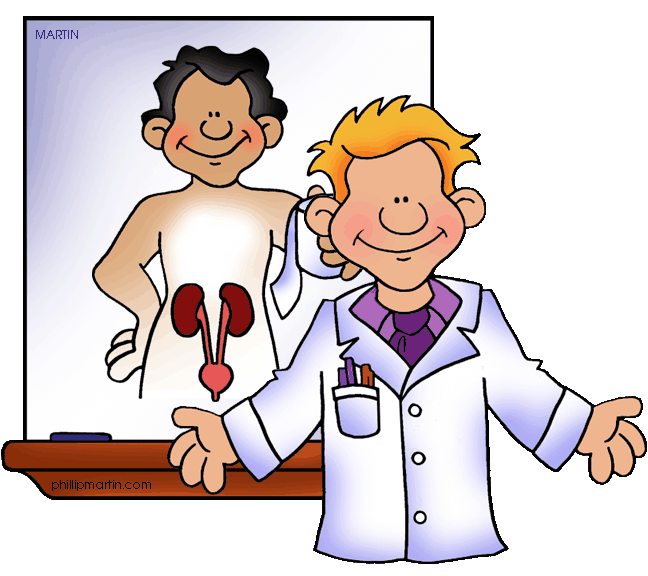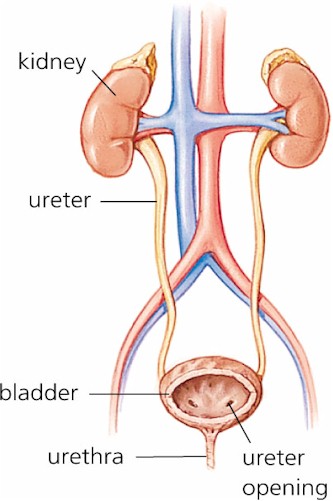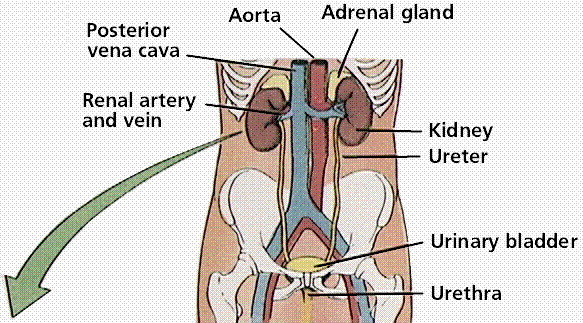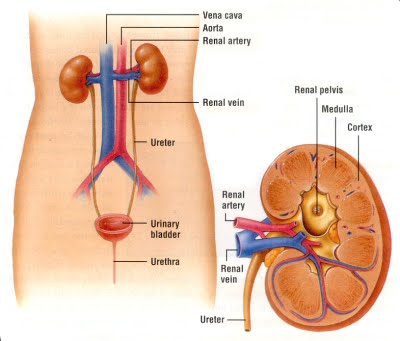The Excretory System:
Function
Function
Overall
Function
The excretory system is responsible for the life function of excretion, or the expulsion of cellular wastes. It gets rid of wastes through the urinary system, sweating, and exhalation. The excretory system helps maintain homeostasis by helping to keep a constant body temperature through sweating, regulating pH levels though the liver, balancing the water and solute balance through the kidneys, and getting rid of potential toxins. The kidneys also control the volume of body fluid. All these functions help to keep a stable internal environment in humans.
More in Depth
The lungs help expel carbon dioxide, heat, and water vapor from the body (more information on this under Lungs in "Structure" tab). The skin removes water, salt, urea, and uric acid via perspiration (more information on this under Skin in "Structure" tab).
As the body carries out life function, proteins and nucleic acids are broken down. As they are broken down, nitrogen is released. Some of this nitrogen is reused to make new compounds, but most of it must be disposed. Ammonia is the first nitrogenous compound to form. It is water soluble, but highly toxic and must be disposed of before it increases the pH level of the body. The liver converts ammonia into urea and uric acid, but mostly urea. Urea is water soluble, and much less toxic than ammonia.
The circulatory system next brings the urea, along with other wastes and extra materials (i.e. glucose, amino acids, ions, vitamins) , to the kidney. This mixture is called filtrate. The filtrate enters the kidneys, specifically the nephrons of the kidneys (see "Structure" tab) through capillaries. This process is called Filtration. The filtrate then goes through a series of cleansings and purifications, wherein the "good stuff" is put back into the bloodstream, and the "bad stuff" is brought further down the urinary system into the collecting ducts, where it all meets. Reabsorption is the process by which water and valuable solutes (such as glucose, salt, ions, amino acids, etc.) are returned to the blood from the filtrate. Secretion is the process by which substances in the blood are transported into the filtrate, and the elimination of certain drugs and toxins from the blood. So reabsorption is the return of the "good stuff" to the blood, and secretion is getting rid of the "bad stuff" out of the blood. Reabsorption and secretion refine the filtrate by diffusion between capillaries and tubules through the interstitial (extra-cellular) fluid.
After secretion and reabsorption are finished, and the filtrate (which is by now only "bad stuff," so is called urine) has made it all the way through the kidney, it collects in collecting ducts. From there, all the collecting ducts feed into the renal pelvis, and the urine makes its way down a tube called a ureter to the bladder. The bladder fills up with urine until it is full, and you feel the urge to pee. Then the sphincter muscle at the bottom of the bladder relaxes and the urine passes out of the body via the urethra (final tube connecting the bladder to outside the body). This last process, wherein the urine passes from the kidneys through the ureters, bladder, and urethra to outside the body is called excretion.
How it Relates to other Body Systems
The Endocrine System regulates the amount of water that the kidneys excrete. Antidiuretic Hormone (ADH) is secreted from the pituitary gland. It is regulated by a negative feedback system to maintain water and salt balance in the blood. A decrease in water (and increase in solute concentration) in the blood signals ADH levels to be increased. ADH tells the kidney to increase water reabsorption, or to put back more "stuff" in the blood. Thus, there is a decrease in urine production. An increase in water (and a decrease in solute concentration) in the blood signals ADH levels to decrease. Water reabsorption decreases, which means that there is more "bad stuff," and thus more urine produced.
The Circulatory System provides transportation for all of the substances used in the excretory system. Urea is taken from the liver to the kidneys by the bloodstream, as are all the dissolved substances. Capillaries allow for the diffusion of materials across their membranes, and therefore allow for reabsorption and secretion. Oxygen and Carbon Dioxide are also diffused through the capillaries in the alveoli of the lungs (more on that under Lungs in "Structures"). The arteries bring waste to the kidneys, and veins take the "good stuff" away to the rest of the body.
The excretory system is responsible for the life function of excretion, or the expulsion of cellular wastes. It gets rid of wastes through the urinary system, sweating, and exhalation. The excretory system helps maintain homeostasis by helping to keep a constant body temperature through sweating, regulating pH levels though the liver, balancing the water and solute balance through the kidneys, and getting rid of potential toxins. The kidneys also control the volume of body fluid. All these functions help to keep a stable internal environment in humans.
More in Depth
The lungs help expel carbon dioxide, heat, and water vapor from the body (more information on this under Lungs in "Structure" tab). The skin removes water, salt, urea, and uric acid via perspiration (more information on this under Skin in "Structure" tab).
As the body carries out life function, proteins and nucleic acids are broken down. As they are broken down, nitrogen is released. Some of this nitrogen is reused to make new compounds, but most of it must be disposed. Ammonia is the first nitrogenous compound to form. It is water soluble, but highly toxic and must be disposed of before it increases the pH level of the body. The liver converts ammonia into urea and uric acid, but mostly urea. Urea is water soluble, and much less toxic than ammonia.
The circulatory system next brings the urea, along with other wastes and extra materials (i.e. glucose, amino acids, ions, vitamins) , to the kidney. This mixture is called filtrate. The filtrate enters the kidneys, specifically the nephrons of the kidneys (see "Structure" tab) through capillaries. This process is called Filtration. The filtrate then goes through a series of cleansings and purifications, wherein the "good stuff" is put back into the bloodstream, and the "bad stuff" is brought further down the urinary system into the collecting ducts, where it all meets. Reabsorption is the process by which water and valuable solutes (such as glucose, salt, ions, amino acids, etc.) are returned to the blood from the filtrate. Secretion is the process by which substances in the blood are transported into the filtrate, and the elimination of certain drugs and toxins from the blood. So reabsorption is the return of the "good stuff" to the blood, and secretion is getting rid of the "bad stuff" out of the blood. Reabsorption and secretion refine the filtrate by diffusion between capillaries and tubules through the interstitial (extra-cellular) fluid.
After secretion and reabsorption are finished, and the filtrate (which is by now only "bad stuff," so is called urine) has made it all the way through the kidney, it collects in collecting ducts. From there, all the collecting ducts feed into the renal pelvis, and the urine makes its way down a tube called a ureter to the bladder. The bladder fills up with urine until it is full, and you feel the urge to pee. Then the sphincter muscle at the bottom of the bladder relaxes and the urine passes out of the body via the urethra (final tube connecting the bladder to outside the body). This last process, wherein the urine passes from the kidneys through the ureters, bladder, and urethra to outside the body is called excretion.
How it Relates to other Body Systems
The Endocrine System regulates the amount of water that the kidneys excrete. Antidiuretic Hormone (ADH) is secreted from the pituitary gland. It is regulated by a negative feedback system to maintain water and salt balance in the blood. A decrease in water (and increase in solute concentration) in the blood signals ADH levels to be increased. ADH tells the kidney to increase water reabsorption, or to put back more "stuff" in the blood. Thus, there is a decrease in urine production. An increase in water (and a decrease in solute concentration) in the blood signals ADH levels to decrease. Water reabsorption decreases, which means that there is more "bad stuff," and thus more urine produced.
The Circulatory System provides transportation for all of the substances used in the excretory system. Urea is taken from the liver to the kidneys by the bloodstream, as are all the dissolved substances. Capillaries allow for the diffusion of materials across their membranes, and therefore allow for reabsorption and secretion. Oxygen and Carbon Dioxide are also diffused through the capillaries in the alveoli of the lungs (more on that under Lungs in "Structures"). The arteries bring waste to the kidneys, and veins take the "good stuff" away to the rest of the body.


Fun Fact!
An increase in urination is known as diuresis, and the presence of ADH opposes diureses. ADH is therefore an "antidiuretic."
An increase in urination is known as diuresis, and the presence of ADH opposes diureses. ADH is therefore an "antidiuretic."
Fun Fact!
Alcohol stimulates the increase of ADH, so there is a lot of water loss, and the person is dehydrated. This accounts for some of the symptoms of a hangover.
Alcohol stimulates the increase of ADH, so there is a lot of water loss, and the person is dehydrated. This accounts for some of the symptoms of a hangover.
Fun Fact!
Urine is slightly acidic.
Urine is slightly acidic.
Fun Fact!
Ammonia is very soluble, so many organisms living in aquatic environments just diffuse it out into the water. That is why you have to change the water in the fish tank so often; because if not, the fish will die. However, Ammonia doesn't diffuse from body fluids into air, so humans had to find another way.
Ammonia is very soluble, so many organisms living in aquatic environments just diffuse it out into the water. That is why you have to change the water in the fish tank so often; because if not, the fish will die. However, Ammonia doesn't diffuse from body fluids into air, so humans had to find another way.
Fun Fact!
Ammonia is 100,000 times more toxic than urea!
Ammonia is 100,000 times more toxic than urea!
Fun Fact! Uric Acid is a semi-solid waste, and the white matter in bird droppings!
Fun Fact!
Toads excrete ammonia while in water, and urea while on land.
Toads excrete ammonia while in water, and urea while on land.
Fun Fact! Humans don't actually need to drink 8 glasses of water a day; that saying is not based on scientific fact at all! The Institute of Medicine stated that thirst is a good guide to the amount of fluids to drink each day.




Very basic diagram of the excretory system. Click to enlarge.
Slightly more detailed diagram. Click to enlarge.
Detailed diagram of the excretory system. Click to enlarge.
VERY detailed diagram!!! I'm not going to go into all these terms, but if you want to see the labels better, click the image to enlarge!
These are some diagrams of the structure of the excretory system. To find out more about these structures, visit the "Structures" tab on the menu above!